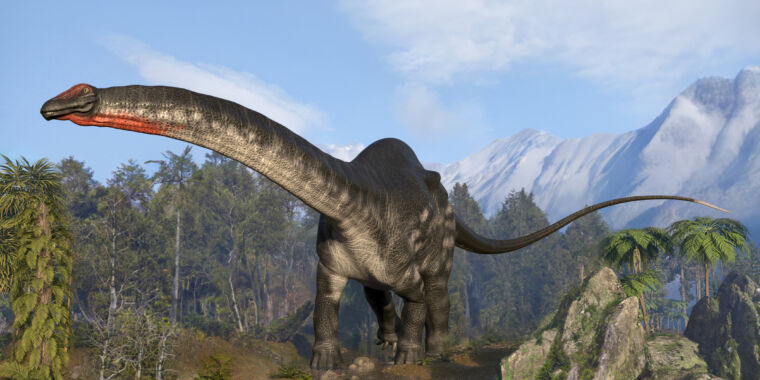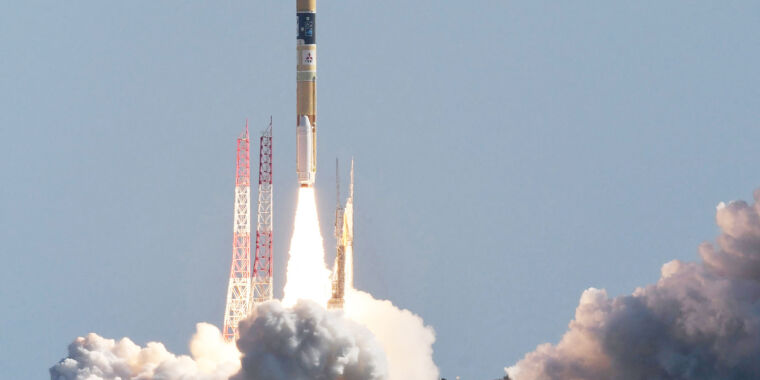
Words I did not expect to read in a scientific paper this week: “The similarity in mass and contact area between modern farm vehicles and sauropods raises the question: What was the mechanical impact of these prehistoric animals on land productivity?” The paper, from Thomas Keller and Dani Or, raises what may be a significant worry: Farm vehicles have grown over the past few decades, to the point where they may be compacting the subsurface soil where roots of crops extend. This poses a risk to agricultural productivity.
The paper then compares that compaction risk to the one posed by the largest animals to ever roam our land: sauropods.
The big crunch
We think of the ground as being solid, but gaps and channels within soil are critical to plant life, since they allow air and water to reach roots. Soil compaction, in its extreme form, gets rid of all these spaces, making the ground much less hospitable for plants. And compaction is hard to reverse; it can take decades of plant and animal activity to break up the compacted soil again and re-establish a healthy ecosystem.
There’s a lot of agricultural hardware dedicated to tilling the soil, breaking the ground up and making it more permeable to air and water. But this hardware doesn’t reach down all that deep. A “subsurface” area remains beneath the tilled soil, but the subsurface is still well within the area used by the roots of agricultural plants.
Obviously, having something heavy roll over the soil is an easy recipe for compacting it. And agricultural hardware is getting increasingly heavy, since larger equipment is more efficient. Back in 1958, a typical combine harvester weighed about 4,000 kg. Today, that average weight has grown to over 35,000 kg. To avoid crushing the soil beneath this bulk, tires have gotten larger, and they’re operated at lower pressures, allowing the tire to spread over a larger area to limit the compaction of the surface soil.
But forces from the surface translate to the subsurface in a way that’s less dependent on the area the compressive force is spread across. Instead, at some depths, the stresses largely depend on the mass per wheel. As such, the growing mass of combine harvesters (and other agricultural equipment) raises the risk that the subsurface will get compacted. That effect will be difficult to detect and correct, but it can result in lost agricultural productivity.
Global risks. Plus dinosaurs!
Compaction risks aren’t evenly distributed. Drier regions have less groundwater to squeeze out and so are less at risk of compaction. Some countries also farm via smaller lots that don’t benefit from the efficiencies provided by large hardware. Still, plenty of areas are at risk of compaction, including the eastern US, eastern Australia, Argentina, and much of Europe. In general, these areas line up well with ones that a separate study has suggested are suffering from lowered productivity due to soil compaction. Overall, about 20 percent of the important agricultural areas are at risk.
Which brings us back to the dinosaur issue. Sauropods got considerably more massive than even the biggest harvesters—they may have approached 80,000 kg. Their weight was spread across only four limbs, with footprints roughly comparable to those of modern tires (harvesters, in contrast, often have six tires). Finally, in order to move, the sauropods had to raise at least one limb at a time. All of these factors combined mean that the sauropods should have put substantially more stress on the soil.
If agricultural equipment now poses a compaction risk, the dinosaurs were almost certainly causing problems. At the same time, however, animals of that size required a flourishing ecosystem to support them. “The potential for significant soil compaction by foraging sauropods seems incompatible with productive land that supported renewable vegetation for feeding these prehistoric herbivores,” as the researchers put it.
How to explain this apparent contradiction? Keller and Or, both of whom specialize in agricultural studies, turn to an idea that’s been a popular in paleontology circles for a while: Anything this big almost certainly was semi-aquatic, since it would struggle to support its bulk. But rather than talking to a paleontologist for more insights, the authors simply declare that “resolving this paradox is beyond the scope of this study.”
PNAS, 2022. DOI: 10.1073/pnas.2117699119pnas.org (About DOIs).








